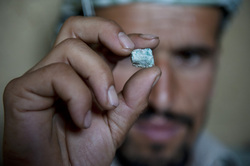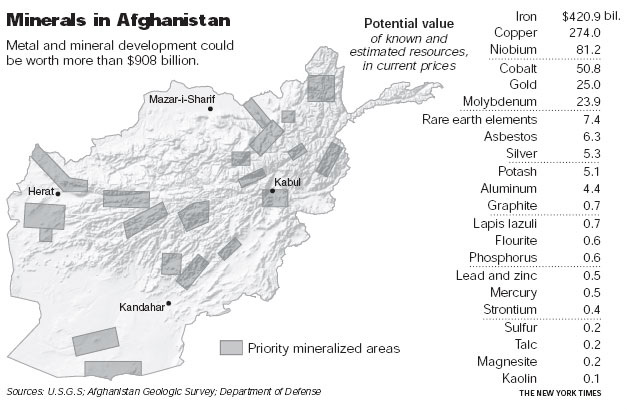Afghanistan Natural Resources
Table of Contents
- Overview
- History
- 2010 Discovery
- PBS video
- Natural Resources Discovered
- Metals
- Industrial Minerals
- Mineral Fuels
____________________________________________________________________________________________________________________________
- History
- 2010 Discovery
- PBS video
- Natural Resources Discovered
- Metals
- Industrial Minerals
- Mineral Fuels
____________________________________________________________________________________________________________________________
Overview

Afghanistan miner shows off Emerald
Afghanistan is a country in Southern Central Asia and throughout history is known as a poverty-stricken country that over the years has been involved in many wars. When many people think of Afghanistan they do not think of a wealth of natural resources but in recent years many natural resources have been discovered in Afghanistan that may change the economy of the country drastically. Now Afghanistan is becoming known as a spot that has an abundance of natural resources such as gold, copper, lithium, natural gases and oil.
____________________________________________________________________________________________________________________________
____________________________________________________________________________________________________________________________
History
According to the New York Times article "U.S. Identifies Vast Mineral Riches in Afghanistan" knowledge of the countries natural resources were discovered when American Geologists were sent to Afghanistan in 2004. While there the geologists discovered old charts and data in the library of Afghan Geological Survey in Kabul, these suggested that Afghanistan had large mineral deposits scattered throughout the country. After discovering these charts and maps, collected by Soviet mining experts in the 1980s, the United States Geological Survey began to survey and research parts of Afghanistan to determine if these charts were accurate. In 2010 after the project was almost forgotten there was a major discovery. (Risen, 2010)
___________________________________________________________________________________________________________________________
___________________________________________________________________________________________________________________________
2010 Discovery
After the Pentagon and the US Geological Survey conducted studies and many calculations they came to the realization that Afghanistan is sitting on nearly $1 trillion of minerals and natural resources. (Sengupta, 2010) After the discovery of copper, gold, cobalt and iron as well as lithium Afghanistan holds the potential to become one of the most sought after mining points in the world. Making Afghanistan a major mining center would be a lot of hard work and would cost a lot of money but many people such as General David Petraeus (Risen, 2010) believe that this could be extremely significant in the long run. With the recent discovery of these vast resources many outside firms have started to bid on the rights to have access to these. Although the discovery of these natural resources are viewed as good many people see potential conflicts that could arise as a result. For example, many Western Diplomats have concerns that the flow of money that is connected with the vast minerals could lead to political corruption within Afghanistan. Jawad Omar, a senior official in the Afghanistan ministry stated, "The natural resources of Afghanistan will play a magnificent role in Afghanistan's economic growth. The past five decades have shown that every time new research takes place, it shows our natural reserves are far more than what was previously found. This is a cause for rejoicing, nothing to worry about." (Sengupta, 2010)
_____________________________________________________________________________________________________________________________
In this video Margaret Warner talks to New York Times reporter James Risen about the Natural Resources found in Afghanistan and the significance of this discovery.
_____________________________________________________________________________________________________________________________
In this video Margaret Warner talks to New York Times reporter James Risen about the Natural Resources found in Afghanistan and the significance of this discovery.
____________________________________________________________________________________________________________________________
Natural Resources Discovered

Metals:
Copper, Gold and Iron Ore were found in great quantities in Afghanistan. Copper was not mined actively in 2006, before this time Copper was mined in several areas throughout the country but because of a lack of infrastructure Copper mining became difficult to continue. Gold has been mined in the Northern Takhar Providence by groups of miners. In the Samti Deposit it is estimated that there is around 20 to 25 metric tons of gold. Iron Ore is best known in the Hajigak iron oxide deposit within Afghanistan; 80% of the deposit is ore, and the remaining 20% consists of three separate ore types. (Kuo, 2007)
Industrial Minerals:
Afghanistan throughout the years has definitely taken advantage of their gemstone deposits that consist of aquamarine, emerald, fluorite, garnet, kunzite, ruby, sapphire, semiprecious lapis lazuli, topaz, tourmaline, and varieties of quartz. Mining of gemstones in Afghanistan is still done my miners in a very primitive fashion and is then exported to India and Pakistan. (Kuo, 2007)
Mineral Fuels:
During the U.S. Geological Survey's studies they found that there were roughly 1,596 million barrels of crude oil, 444 cubic meters of natural gas, and 562 Mbbl of natural gas liquids. (Kuo, 2007)
____________________________________________________________________________________________________________________________
Copper, Gold and Iron Ore were found in great quantities in Afghanistan. Copper was not mined actively in 2006, before this time Copper was mined in several areas throughout the country but because of a lack of infrastructure Copper mining became difficult to continue. Gold has been mined in the Northern Takhar Providence by groups of miners. In the Samti Deposit it is estimated that there is around 20 to 25 metric tons of gold. Iron Ore is best known in the Hajigak iron oxide deposit within Afghanistan; 80% of the deposit is ore, and the remaining 20% consists of three separate ore types. (Kuo, 2007)
Industrial Minerals:
Afghanistan throughout the years has definitely taken advantage of their gemstone deposits that consist of aquamarine, emerald, fluorite, garnet, kunzite, ruby, sapphire, semiprecious lapis lazuli, topaz, tourmaline, and varieties of quartz. Mining of gemstones in Afghanistan is still done my miners in a very primitive fashion and is then exported to India and Pakistan. (Kuo, 2007)
Mineral Fuels:
During the U.S. Geological Survey's studies they found that there were roughly 1,596 million barrels of crude oil, 444 cubic meters of natural gas, and 562 Mbbl of natural gas liquids. (Kuo, 2007)
____________________________________________________________________________________________________________________________
References
Kuo, Chin S. (September 2007). The Mineral Industry of Afghanistan. In USGS. Retrieved September 21, 2011.
Risen, James. (June 13, 2010). U.S. Identifies Vast Mineral Riches in Afghanistan. In The New York Times. Retrieved September 21, 2011, from http://www.nytimes.com/2010/06/14/world/asia/14minerals.html.
Sengupta, Kim. (June 15, 2010). Afghanistan's resources could make it the richest mining region on earth. In The Independent. Retrieved September 20, 2011, from http://www.independent.co.uk/news/world/asia/afghanistans-resources-could-make-it-the-richest-mining-region-on-earth-2000507.html.
Risen, James. (June 13, 2010). U.S. Identifies Vast Mineral Riches in Afghanistan. In The New York Times. Retrieved September 21, 2011, from http://www.nytimes.com/2010/06/14/world/asia/14minerals.html.
Sengupta, Kim. (June 15, 2010). Afghanistan's resources could make it the richest mining region on earth. In The Independent. Retrieved September 20, 2011, from http://www.independent.co.uk/news/world/asia/afghanistans-resources-could-make-it-the-richest-mining-region-on-earth-2000507.html.
Picture References
Saeedi, Majid. (July 13, 2010). Emerald Mining In The Panjshir Valley, Afghanistan. In Zimbio. Retrieved September 20, 2011, from http://www.zimbio.com/pictures/AqYRuc-bCHE/Emerald+Mining+Panjshir+Valley+Afghanistan/wt7pB3kh9In.
(February 17, 2011). Maps & Charts. In The DOSSIER. Retrieved September 21, 2011, from http://www.thedossier.info/maps_charts.htm.
(February 17, 2011). Maps & Charts. In The DOSSIER. Retrieved September 21, 2011, from http://www.thedossier.info/maps_charts.htm.
